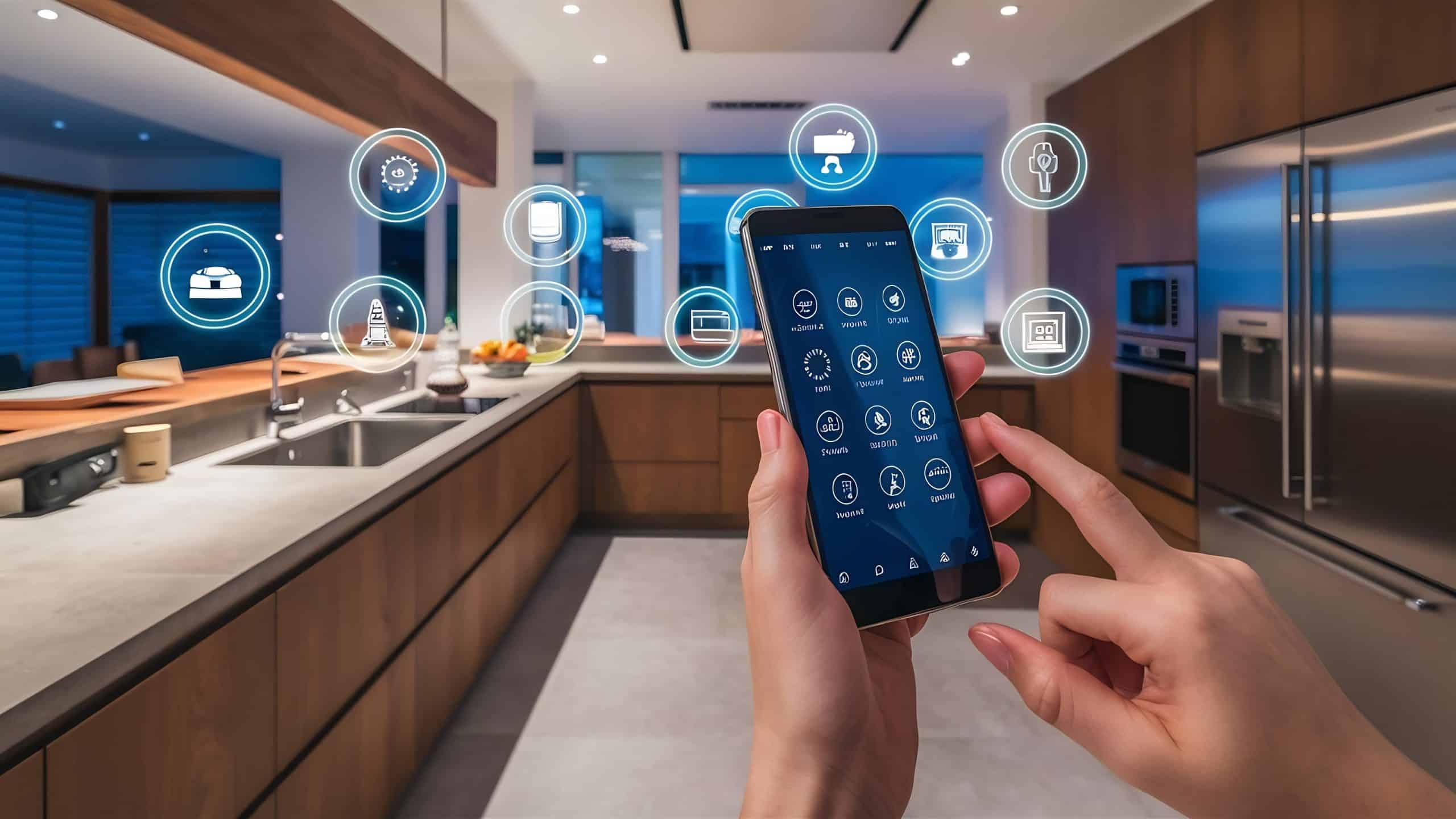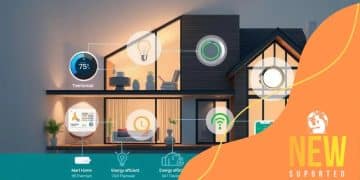AI-integrated smart homes: The future of living

Imagine living in a space that understands your habits, anticipates your needs, and helps you save money. AI-integrated smart homes are no longer a distant vision—they’re reshaping how we experience everyday life.
These next-gen living spaces combine smart technology, security enhancements, and energy efficiency to deliver convenience like never before.
Let’s explore how this powerful blend of AI and home automation is transforming the way we live.
Understanding AI-integrated smart homes
To truly appreciate the potential of AI-integrated smart homes, you need to understand what they do. These homes are built around automation, learning algorithms, and connected devices that adapt to your lifestyle.
Imagine your lights dimming automatically in the evening or your thermostat adjusting based on your weekly routine. These homes go beyond convenience—they deliver comfort, safety, and efficiency through seamless integration.
Key components of AI-integrated smart homes
A fully functioning AI-integrated smart home relies on multiple components working in harmony:
-
Smart Sensors: Detect motion, light, and temperature changes to adjust settings automatically.
-
Home Assistants: Devices like Amazon Echo or Google Home act as central hubs for voice and app control.
-
Security Systems: AI-powered cameras and alarms provide real-time monitoring and smart alerts.
-
Smart Appliances: Fridges, ovens, washers, and other devices that connect remotely and automate tasks.
Together, these elements form a cohesive ecosystem that makes life easier and more efficient. Smart homes not only streamline routines but also reduce your energy consumption.
Even better, you don’t need to overhaul your entire home at once. Start small—with a smart speaker or a lighting system—and scale up as you become more familiar with the technology.
Key features of smart home technology
The true value of smart home technology lies in its core features—automation, connectivity, security, and energy management. These features combine to offer a personalized, efficient living experience.
Automation
Tasks like adjusting lighting, locking doors, or changing the thermostat can happen automatically, based on your behavior.
Connectivity
Device communication is what makes smart homes intelligent:
-
Remote Access: Control your home from anywhere.
-
Cross-Compatibility: Devices from different brands can work together.
-
Customization: Set routines that fit your lifestyle and preferences.
Security
Smart homes offer 24/7 protection with features like facial recognition, AI-powered cameras, and motion detectors that notify you of threats instantly.
Energy Management
Track your energy use with smart plugs, adaptive lighting, and AI-generated energy reports that help you save money and live sustainably.
How AI enhances home security

Artificial intelligence is revolutionizing home security, making it more intelligent, responsive, and proactive. As smart devices become more accessible, homeowners are gaining powerful tools that offer both peace of mind and greater control over their surroundings.
Intelligent Threat Detection
One of AI’s most significant contributions is its ability to identify unusual activity with impressive accuracy. Smart security cameras powered by AI can differentiate between routine movements, like a pet walking across a room, and potential threats, such as an unfamiliar person lingering near the front door.
This reduces false alarms and ensures that real dangers trigger instant alerts—keeping your family and property safer.
- 🔒 Example app: Arlo Secure uses AI to distinguish between people, animals, vehicles, and packages, sending customized notifications based on what it detects.
Smart Surveillance Systems
Modern AI-enhanced surveillance offers features far beyond simple motion detection:
-
Facial Recognition: Helps identify known visitors and alerts you to strangers.
-
Real-Time Monitoring: Access live camera feeds from anywhere using your smartphone or tablet.
-
Automated Alerts: Get notified instantly when the system detects something unusual.
-
Integrated Response: Devices like cameras, alarms, and smart lights work together to deter intrusions.
- 🛡️ Example app: Nest Aware (from Google Nest) offers face detection and activity zones to help you monitor specific areas more precisely.
Advanced Access Control with Smart Locks
Smart locks take entry security to a new level. Many models offer fingerprint access, temporary guest codes, or remote unlocking via smartphone apps, removing the need for physical keys altogether.
This ensures that only authorized individuals can enter your home—whether you’re present or not.
- 🔐 Example app: August Home allows you to lock or unlock your door remotely, view a 24/7 activity feed, and grant temporary access to friends or service providers.
Learning Your Routine
AI security systems can also learn your habits over time. For example, if you usually arrive home at 6 PM, the system can adjust alert thresholds accordingly—reducing unnecessary notifications and improving response accuracy when you’re away.
This personalized approach makes the system more effective and less intrusive.
Seamless Integration Across Devices
Security is even stronger when all smart home devices work together. For instance, if a security camera detects motion after dark, it can automatically turn on smart outdoor lights and activate an indoor alarm—all without your input.
This interconnected response enhances protection and reinforces your entire home security network.
- 🧠 Example app: Samsung SmartThings allows various devices—cameras, lights, sensors, and alarms—to be connected into a unified ecosystem that responds intelligently to threats.
Incorporating AI into home security systems offers a comprehensive approach to safeguarding your home. From enhanced surveillance to automated responses, AI technology brings powerful tools to protect your loved ones and property.
Energy efficiency benefits of AI in homes
Energy efficiency benefits of AI in homes are becoming increasingly important as homeowners seek to reduce costs and promote sustainability.
AI technology can optimize energy consumption, helping people save money on utility bills while also reducing their environmental impact.
One of the key advantages is smart energy management. AI systems can analyze energy usage patterns in your home and suggest optimal settings.
For instance, a smart thermostat learns your schedule and adjusts temperatures accordingly, ensuring you are not heating or cooling an empty house.
Automated Energy Controls
AI can automate energy controls across various devices, allowing for seamless integration. This means that when the sun rises, smart blinds can open to take advantage of natural light, reducing the need for electric lighting.
- Adaptive Lighting: Lights can adjust brightness based on the time of day and occupancy.
- Smart Outlets: These can shut off power to devices that are not in use, cutting down on wasted energy.
- Energy Usage Reports: AI provides insights on how and when you use energy, helping you make informed choices.
Another benefit is the integration of renewable energy sources. AI can smartly manage energy use from solar panels or wind turbines, optimizing their output based on your household’s needs.
This ensures that energy generated from these sources is used effectively.
Furthermore, predictive analytics can help in determining the best times to use certain appliances.
For example, AI can recommend using washing machines or dishwashers during off-peak hours when energy rates are lower. This not only saves money but also contributes to energy conservation.
Overall, incorporating AI into home energy management leads to enhanced efficiency and significant savings.
By automating and optimizing energy consumption, homeowners can enjoy both comfort and lower bills while contributing positively to the environment.
Future trends in smart home technology
Future trends in smart home technology are shaping the way we live and interact with our environments. As technology continues to evolve, smart homes are becoming more sophisticated and user-friendly.
One emerging trend is the rise of voice-activated systems. More households are adopting devices like Amazon Alexa and Google Assistant, allowing users to control various home features through simple voice commands.
This hands-free approach enhances convenience and accessibility.
Integration of AI and Machine Learning
Another significant trend is the deeper integration of artificial intelligence (AI) and machine learning into smart home systems. These technologies allow devices to learn from users’ behaviors and preferences over time.
For instance, smart thermostats can optimize energy use by predicting your ideal temperature based on past behavior.
- Personalized Experiences: Smart homes will tailor their functionalities to individual habits.
- Improved Security: AI can enhance security systems by identifying patterns that indicate threats.
- Increased Automation: Devices will work together more seamlessly to create a cohesive living experience.
Moreover, sustainability is taking center stage. Future smart homes are likely to include more energy-efficient technologies. Innovations like solar panel integration combined with AI can optimize energy consumption even further.
This trend not only reduces utility bills but also minimizes the environmental footprint.
As remote work becomes more common, smart home technology will also adapt to support productivity.
Devices designed for home offices are likely to see increased functionality, offering features like automated lighting adjustments and ergonomic settings to enhance comfort during work hours.
Additionally, interoperability among devices is expected to improve significantly. Future smart homes will see devices from different manufacturers communicating effectively, creating a unified smart home ecosystem.
This will allow for higher efficiency and simpler controls.
FAQ – Frequently Asked Questions about AI-Integrated Smart Homes
What are AI-integrated smart homes?
AI-integrated smart homes are residences equipped with smart technology that uses artificial intelligence to automate tasks and enhance living experiences.
How does AI improve home security?
AI enhances home security by using smart surveillance, facial recognition, and real-time monitoring to detect unusual activities and send alerts.
What energy efficiency benefits do smart homes offer?
Smart homes can optimize energy consumption through automation, adjusting climate controls based on user habits, which reduces utility costs and environmental impact.
What future trends can we expect in smart home technology?
Future trends include increased voice activation, better AI integration, greater energy efficiency, and improved interoperability among devices for a seamless smart home experience.
AI-integrated smart homes are more than a tech upgrade—they’re a lifestyle transformation. These intelligent systems bring together security, efficiency, and personalization, helping you live smarter every day.
Whether you start with one device or fully automate your home, the impact is immediate: less effort, lower bills, and a better quality of life.
Liked the article?





